02 November 2024
![]() 10 mins Read
10 mins Read
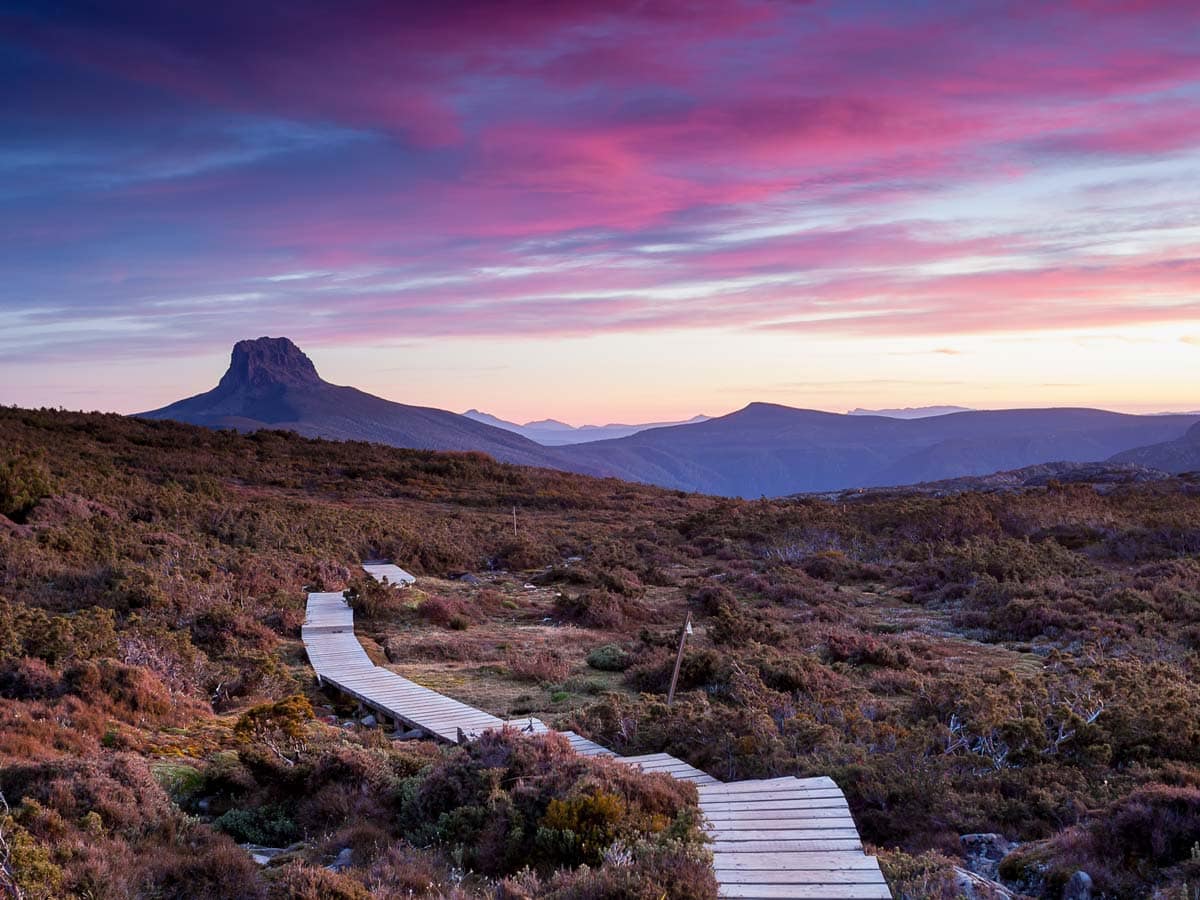
Glacially carved valleys, ancient rainforests, buttongrass moorlands, alpine meadows and an iconic mountain: experience for yourself what makes Tasmania’s six-day Overland Track one of the most legendary long-distance wilderness hikes in the world.
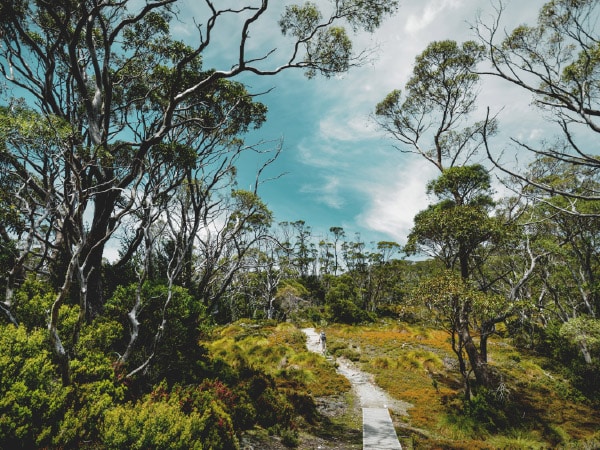
The Overland Track passes through ancient rainforest.
Traversing 65 kilometres of remote terrain through Tasmania’s Central Highlands, the Overland Track is Australia’s top alpine walk.
It winds through Cradle Mountain-Lake St Clair National Park, which – part of the Tasmanian Wilderness World Heritage Area – is recognised for both its natural and cultural heritage: for tens of thousands of years, the palawa people have used, managed, modified and lived here among the alpine heaths and rainforest. Early European activities of hunting, surveying, mining and logging never quite took grip although several of the area’s present-day walking trails were made for these purposes.
The thousands of hikers who undertake the Overland Track each year follow in the footsteps of local hunters who blazed the trail 100 years ago, connecting an existing network of trails, some of which are rumoured to follow palawa paths. The Overland Track has evolved into one of the world’s great wilderness walks and helped cement Tasmania’s position at the forefront of ecotourism in Australia.
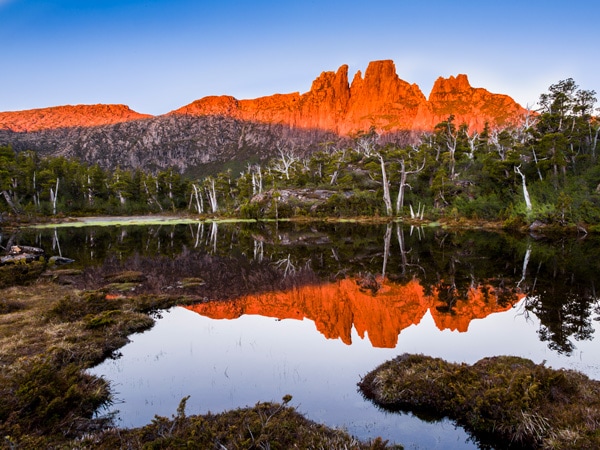
The Overland Track is Australia’s top alpine walk.
The Overland Track is 65 kilometres long. And while it takes an average of six days to walk, hikers can set their own pace depending on how many rest days and side trips (such as the Cradle Mountain summit or Tasmania’s highest peak, Mt Ossa) they choose to factor in.
During the booking season (fees apply, see below), hikers are required to walk north to south, starting at Cradle Mountain and finishing at Lake St Clair. Outside of the summer period, the Overland can be walked in either direction. Numbers are capped at 34 departures per day to reduce the potential for long-term damage to fragile remote bush environments.
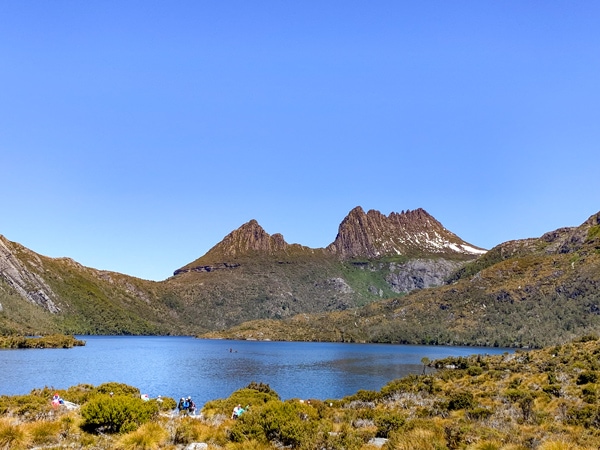
Take in a stunning view of Lake St Clair at the end of your journey.
The Overland Track is classified at grade 4 (‘bushwalking experience recommended. Tracks may be long, rough and very steep. Directional signage may be limited’). Spanning 65 kilometres that includes plenty of ascents and descents, plus a large part above 1000 metres in elevation on exposed plateaus, it is a serious undertaking.
Hikers must be well-prepared and equipped with the right kit (good hiking boots and a decent backpack for starters), with a good level of fitness and mobility and an understanding of the risks – such as unpredictable weather – involved in walking in a remote alpine area. Tasmania Parks and Wildlife Service (PWS) has comprehensive notes and resources on how to prepare for your trip.
The Overland Track is not recommended for children under eight.
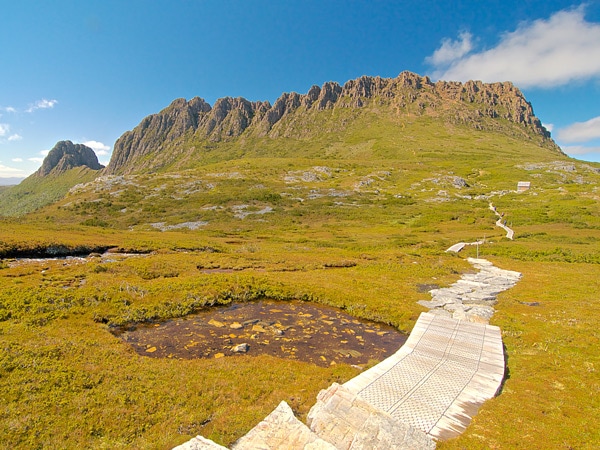
The Overland Track is 65 kilometres long and takes an average of six days to walk.
The ideal time to walk the Overland Track is in the summer and autumn months between December and April when the weather is typically warmest and the days are longer. But, this being the wilds of Tasmania means you must be prepared for all types of weather, at any time. When I walked the Overland Track in late November, it snowed.
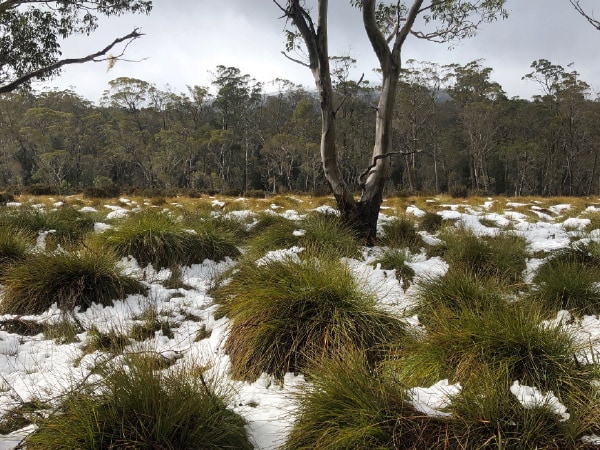
Snow melts over the buttongrass plains during winter.
Independent walkers will either camp or hunker down in one of the trail’s public huts – or a mixture of both. The rustic huts offer wooden bunks, space for cooking and eating and composting toilets and are available on a first-come-first-served basis, meaning even if you plan to stay in a hut you must carry a tent in case it is fully occupied on your arrival.

The Kitchen Hut on the Overland Track.
If you’d rather not rough it, book a trip with Tasmanian Walking Company, which provides the only private accommodation on the trail.
Its five discreet huts – Barn Bluff, Pine Forest Moor, Pelion Plains, Kia Ora and Windy Ridge – were built lightly on the land to exacting environmental standards (including with a wastewater filtration system designed in conjunction with PWS).
They are simple, solar-powered structures with basic but comfortable bedrooms and bathrooms with hot showers, and offer a luxurious-feeling refuge – including homemade meals such as slow-baked penne with fresh-baked bread, apple and rhubarb crumble, and local wines – after a day in the elements.
Bookend your trip with a stay in one of Cradle Mountain’s best accommodation options. Some rooms at the luxe Peppers Cradle Mountain Lodge even have their own private hot tub. Your muscles will thank you later.
The majority of people hike the Overland Track as an independent walker, but several private companies offer a guided walk experience and catering.
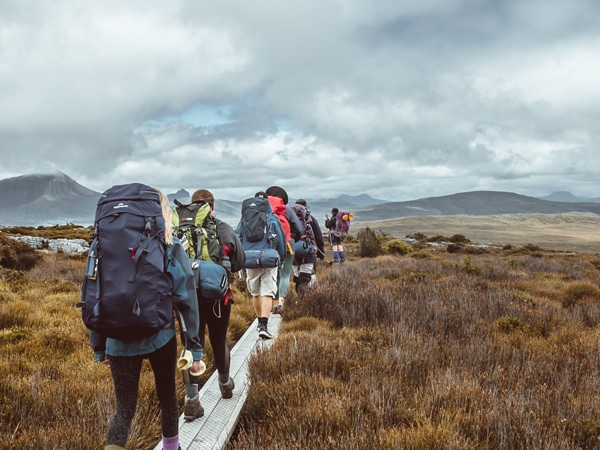
Beginner hikers might want to consider guided tours for added comfort. (Image: Tayla Gentle)
Intrepid’s Trek the Cradle Mountain Overland Track guided walk includes all organisation (from tickets and permits to camping gear) taken care of, meals, and transport to and from Launceston. You’ll camp in the bush each night and benefit from the local knowledge of two expert mountain guides.
Tasmanian Walking Company offers four versions of its Overland Track experience, from the four-day Waldheim to Arm River trip, to the challenging Adventure trip (which includes some serious peak summits along the way, including Cradle Mountain itself) and from the expedition-level Winter option, to the signature six-day Overland Track. In each permutation, walkers are accompanied by expert guides who turn chef each evening, only need to carry a lightweight pack, and retreat each night to a hot shower, good food and wine, and a comfortable bed in one of its eco-friendly private huts.
Tasmanian Walking Company installed its first four private huts on the track in 1987 (a fifth was added in 1997), opening the elemental journey up to travellers who might not otherwise find it accessible.
“Something I’m passionate about is the fact there’s this market for people who wouldn’t go on these trips if it wasn’t for the huts,” says Tasmanian Walking Company general manager Heath Garratt, who started working for the company in 1998 as a guide and in various permutations has walked the track over 100 times. “And the reason I get stuck in and get excited about it is that I love the wilderness,” he says. “I really love seeing people’s reaction to it – seeing them get affected by it. I think connection to the wilderness and the Earth generally is just so critical and it’s something we’ve lost sight of.”
During the summer booking season between October to May, fees apply to walk the Overland Track as an independent walker:
Book your spot in advance via the PWS website – reservations for the season each year open on 1 July.
Walking the Overland Track in winter (June to September) is free but registration is still required.
A valid parks pass is also required for entry to Tasmania’s national parks. See here for fees.
The northern city of Launceston is Tasmania’s gateway to Cradle Mountain–Lake St Clair National Park. There are direct flights from Melbourne, Sydney, Brisbane, Gold Coast, Adelaide and Perth.
Head to Cradle Mountain Visitor Centre, a two-hour drive from Launceston via Sheffield, and take a shuttle to the start of the Overland Track at Ronny Creek, within the park. The trail finishes on Lake St Clair, which is an equidistant 2.5 hours’ drive from both Launceston and Hobart.
Local operators such as Overland Track Transport can arrange a car shuffle, meaning your car is waiting for you at Lake St Clair at the end of the walk.
Alternatively, it can be easier to leave the car altogether and arrange ground transportation with a local operator. Overland Track Transport runs daily services between Launceston and Cradle Mountain and from Lake St Clair to Launceston and Hobart. See here for more operators.
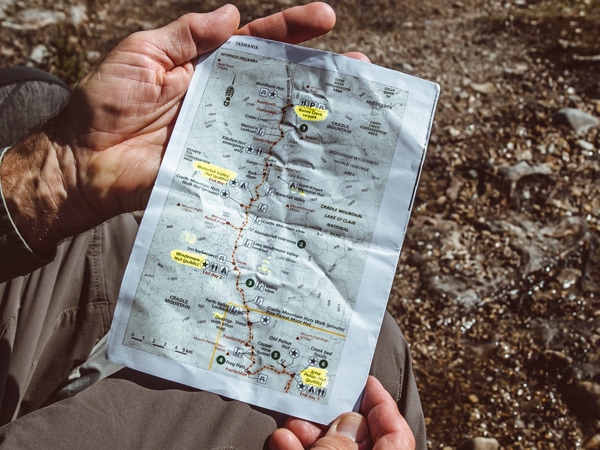
Consider the Overland Track Transport to get from Launceston to Cradle Mountain and from Lake St Clair to Launceston and Hobart. (Image: Tayla Gentle)
For those independent walkers not hiking as part of a guided tour where meals or even private hut accommodation is provided, you’ll need to be completely self-sufficient. The mantra here is pack light but pack right.
Essential items required include:
With its magnificent remote landscapes, walking the Overland Track through the heart of Tasmania’s high country will stir your soul and stay with you forever. However, it is a significant undertaking so be sure to consult PWS’s comprehensive resources on the trail while planning your trip, including its safety checklist and walker pack list.
And with thousands of people walking the Overland Track every year, it’s imperative that everyone does their part to take care of the remarkable but fragile environment they are passing through.
Let the Leave No Trace principles be your guide: plan ahead and prepare; walk and camp on durable surfaces; dispose of waste; leave what you find; minimise campfire impacts – use a fuel stove; respect wildlife; be considerate of your hosts and other visitors.
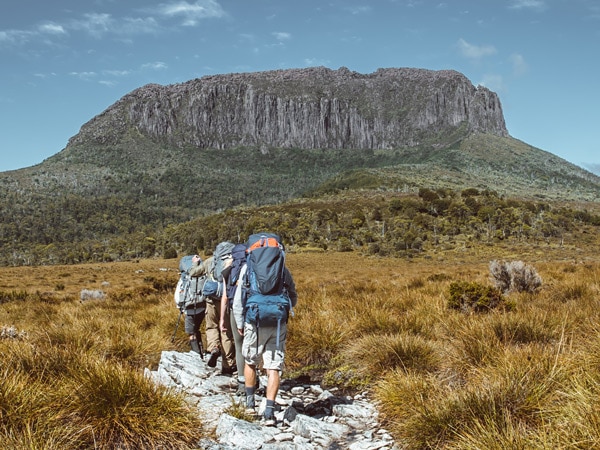
It’s imperative that everyone does their part to take care of the environment they are passing through. (Image: Tayla Gentle)
I walked in spring and encountered snow – a testament to the fact that you can expect any type of weather up here in the wilds of Tasmania’s alpine country at any time of year.
My highlights included the steep climb to Marions Lookout, where the ragged peaks of Cradle Mountain tore through leaden clouds like the gothic castle of Gormenghast. Dove Lake – gunmetal grey on this day – lay like a moat at its foot but just the week before, hikers were swimming in it.
Watching in wonder as a frosty wombat shuffled across the snow and disappeared into its burrow.
A walk through the aptly named Enchanted Forest as the sun broke free for golden hour and illuminated the snow melt on the canopy.
Retreating to the warmth and comfort of Tasmanian Walking Company’s eco huts each night for a home-cooked meal, local wines, good conversation with fellow walkers, and sleeping soundly with a hot-water bottle ahead of the next day’s adventure.
Other highlights walkers can expect include passing through glacially carved valleys, myrtle-beech rainforest and buttongrass moorlands, and skirting alpine lakes lined with pencil pines while the sentinel of Cradle Mountain looms large.
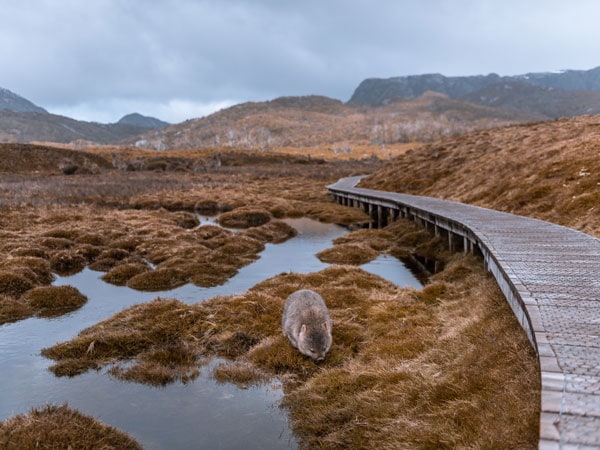
A wombat near Rooney Creek along the Cradle Valley Board Walk. (Image: Jess Bonde)
LEAVE YOUR COMMENT